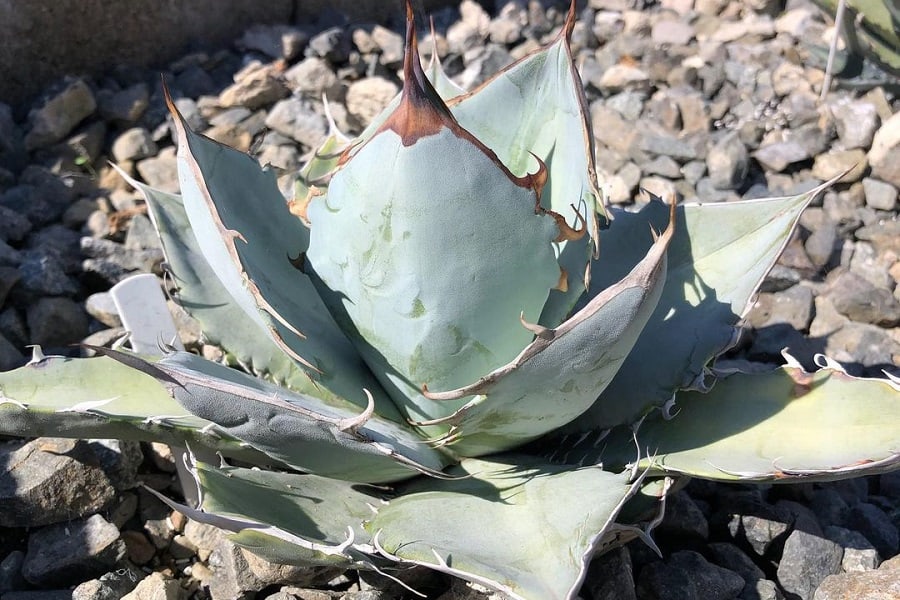Agave titanota ‘White Ice’ – The Frosty Beauty Your Garden Needs
Boring garden? Wake it up with Agave titanota ‘White Ice’ – the frosty, otherworldly succulent that commands attention! This sculptural stunner radiates thick, broad leaves in a perfect rosette, glazed in alluring shades of grayish-white and green. But look closer – slender wavy lines decorate the fleshy foliage and reddish-brown teeth line the dramatic black-tipped margins.

Just imagine this bold, textural beauty standing out among your other plants. The undeniable wow factor of Agave titanota ‘White Ice’ will stop neighbors in their tracks and make you the envy of the neighborhood. Yet it’s a cinch to grow if you know the secrets – let’s dive in!
Contents
About Agave titanota ‘White Ice’
The Agave titanota is a relatively small species, growing only 1-2 feet tall and wide. The ‘White Ice’ cultivar gets its distinctive icy blue coloring from the thick, waxy coating on the leaves. This bloom helps protect the plant from intense sunlight and drying winds in its native habitat.
Hardy from USDA zones 8-10, this cold-tolerant agave can survive brief dips down to around 15-20°F. But prolonged freezing temperatures will damage or kill the plant, so bring potted specimens indoors when frost threatens.
Like other agaves, the thick, succulent leaves are armed with wicked curved spines along the margins. Handle this plant with care to avoid getting stuck! Plant in a spot away from high foot traffic areas.

Related Post:
70+ Types of Agave Plants with Pictures
Agave titanota White Ice Care Guide
Light
The ghostly Agave titanota ‘White Ice’ needs at least 6 hours of direct sun per day to maintain its cool blue hues. A south or east facing spot is ideal. If growing indoors, supplement with a grow light placed 6-12 inches away for 14-16 hours per day.
Water
Drought-tolerant like other agaves, the ‘White Ice’ stores water in its thick leaves and only needs watering every 2-3 weeks in the growing season. Allow the soil to completely dry out before watering again. Too much water can cause rot.
In winter when dormant, only provide enough water to keep the leaves from shriveling – around once a month. Good drainage is essential to prevent soggy soil.
Soil

This striking agave prefers a very well-draining potting mix or soil amended with generous amounts of coarse sand, perlite or pumice. A slightly acidic to neutral pH of 6.0-7.5 is best.
Fertilizer
A shot of diluted balanced fertilizer like 10-10-10 in early spring when growth begins can give plants a nutrient boost. Go easy though, as too many salts can accumulate and burn agave leaves.
Temperature
The ideal temperature range for Agave titanota ‘White Ice’ is 65-85°F. It can tolerate light freezes but extended cold below 25°F can damage the plant.
Pot Size

Agave grow very slowly and don’t need frequent repotting. A 10-12 inch diameter pot can accommodate this small agave for many years before it becomes rootbound.
When potting or transplanting, be careful not to bury the rosette base below the soil line as this can cause rot. Leave the bottom leaves exposed.
Pests and Problems
Agave titanota ‘White Ice’ is remarkably resistant to most pests and diseases when provided with the right growing conditions. However, keep an eye out for agave snout weevils – plump beetle larvae that can burrow into the leaves and stems, eventually causing collapse of the plant.
The biggest threat is improper watering or poor drainage, which can lead to root and stem rot. Make sure the soil dries out completely between waterings and provide excellent drainage to prevent this succulent beauty from developing fungal issues. With proper care, your frosty ‘White Ice’ agave should remain healthy for years to come.
How To Propagate Agave titanota White Ice
One of the best things about Agave titanota ‘White Ice’ is how easy it is to multiply this frosty beauty in your garden! You can expand your collection by propagating new plants from offsets or seeds.
From Offsets/Pups
- Remove offsets/”pups” from the base of the parent plant by gently pulling them away, keeping the roots intact
- Allow the offsets to callus over for a few days before replanting by leaving them in a shady spot
- Plant the offsets in a well-draining cactus/succulent potting mix
- Water sparingly at first until roots become established
- Once showing new growth, treat offsets the same as mature agave plants
From Seed
- Sow fresh agave seeds in a well-draining seed starting mix
- Cover seeds very lightly with soil mix
- Keep seeding trays moist but not soaked
- Provide bright, indirect light and temperatures around 70°F
- Once sprouted, slowly acclimate seedlings to higher light levels
- Be patient – agave can take years to reach mature size from seed
Whether propagating from pups or seeds, the key is providing excellent drainage to prevent rot. With a little time, you’ll have an endless supply of striking ‘White Ice’ agaves!
